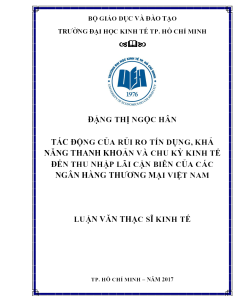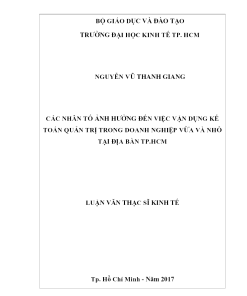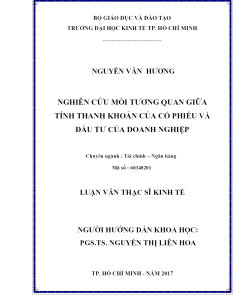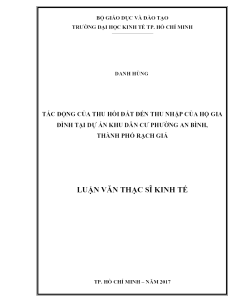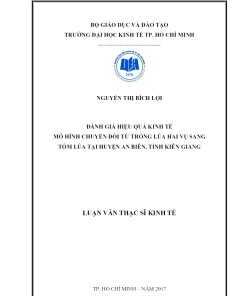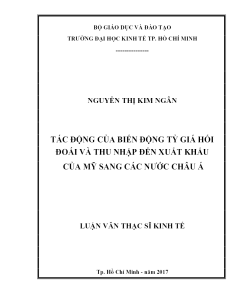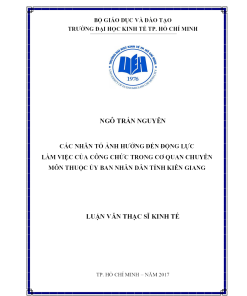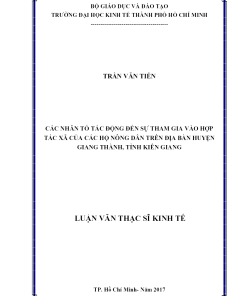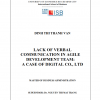- Giảm 10% phí tải tài liệu khi like và share website
- Tặng 1 bộ slide thuyết trình khi tải tài liệu
- Giảm 5% dịch vụ viết thuê luận văn thạc sĩ của Luận Văn A-Z
- Giảm 2% dịch vụ viết thuê luận án tiến sĩ của Luận Văn A-Z
Lack of verbal communication in agile development team: a case of Digital Co., Ltd
50.000 VNĐ
Download Master Thesis: Lack of verbal communication in agile development team: a case of Digital Co., Ltd
Download Master Thesis: Lack of verbal communication in agile development team: a case of Digital Co., Ltd
IT software industry is now one of the most rapidly growing industries among south east ASIAN counties since the majority of IT software companies in China has been charging even higher than what the other developed counties do [1]. Especially since Donald Trump was elected as the 45th and current president of the United States of America, it has been getting harder politically for most of the American software companies to keep involving into Chinese market [2].
Many has moved their software engineering resource pool from China to other south east countries such as Taiwan, Philippine and Vietnam [3]. In addition to such tailwind for those countries, the strong political and economic supports in IT software industry by Vietnamese government toward foreign IT companies and investors and the strong labor force growth in service sector have lead Vietnam to be one of the top countries to export IT software services such as implementation and testing [4]. This has led to more and more international and regional companies looking to Vietnam to build technological resources.
This trend has been very popular in recent years, along with that, the capacity and responsibility of the indigenous engineering team are increasingly appreciated. From that, the competition in term of human resource in the market according to investment and development trends is getting higher. Therefore, the question is how to ensure the team has the capacity to compete and to meet not only customer needs but also the development trend of the industry.
DSC, a 100% Vietnamese IT software development company, provides its own logistic software products and many services to foreign companies mainly in Vietnam or Japan. DSC wants to keep up with the development trend, improve the competitiveness with other companies of the same scale by upgrading the operational structure of each programming team under the Agile model, which became widely known in 2016 though the publication by the Agile Alliance [5], in order to reach the flexible and effective level of programming.
The application of this model to 20 employees in the company made DSC face certain difficulties related to human resource management and information sharing among employees in its organizations. This project will clarify why DSC is having problems with the radical model being applied more and more in the information technology market, in order to study feasible solutions to strengthen the programming team’s power according to Agile model effectively.
Keywords: Business communication, Communication in organizations
TABLE OF CONTENTS
LIST OF FIGURES………………………………………………………………………………………….. 1
LIST OF TABLES……………………………………………………………………………………………. 1
Executive Summary………………………………………………………………………………………….. 2
Acknowledgements …………………………………………………………………………………………… 4
I. INTRODUCTION ……………………………………………………………………………………… 5
II. PROBLEM CONTEXT ……………………………………………………………………………… 7
1. Organizational Structure ……………………………………………………………….. 7
2. Team A Structure ………………………………………………………………………….. 8
2.1 Description of the role in team A …………………………………………………. 8
2.2 Description of working method Agile …………………………………………… 9
2.3 Apply Agile for team A …………………………………………………………….. 10
3. The case……………………………………………………………………………………….. 10
III. PROBLEM IDENTIFICATION ………………………………………………………………. 18
1. Possible Problems ………………………………………………………………………… 18
1.1 Insufficient information sharing …………………………………………………. 18
1.2 Work overload …………………………………………………………………………. 20
1.3 Weak customer relationship management ……………………………………. 22
2. Problem Validation………………………………………………………………………. 23
IV. CAUSE VALIDATION…………………………………………………………………………….. 26
1. Possible Causes…………………………………………………………………………….. 26
1.1 Lack of verbal communication …………………………………………………… 26
1.2 Barriers with knowledge sharing ………………………………………………… 28
1.3 Lack of team goal awareness ……………………………………………………… 30
2. Cause Validation ………………………………………………………………………….. 32
V. ALTERNATIVE SOLUTION…………………………………………………………………… 33
1. Alternative Solutions ……………………………………………………………………. 33
1.1 The first alternative solution: Using software Jira to manage the
project …………………………………………………………………………………….. 33
1.2 The second alternative solution: Offering training course to improve verbal skills ……………………………………………………………………………… 35
2. Solution Validation ………………………………………………………………………. 36
VI. ORGANIZATION OF ACTIONS …………………………………………………………….. 37
VII. CONCLUSION ………………………………………………………………………………………… 39
VIII. SUPPORTING INFORMATION …………………………………………………………….. 40
REFERENCES ………………………………………………………………………………………………… 57
Lack of verbal communication in agile development team: a case of Digital Co., Ltd
LIST OF FIGURES
Figure 1: Organizational Structure Figure 2. Team A’s structure Figure 3. Roles in team A
Figure 4. Agile methodology
Figure 5. Contract discussion between DSC and Vietstar
Figure 6. Preliminary Cause – and – Effect Tree
Figure 7. Main Cause – Effect Tree
LIST OF TABLES
Table 1. Contract value came from Vietstar
Table 2. Project size analysis in term of number of men and time length
Table 3. Project size analysis by DSC’s view based on man-days
Table 4. Time comparison between normal estimate and Vietstar’s requirement
Table 5. Record of customer’s complaints from 2015 to 2019
Table 6. Contents of complaints
Table 7. DSC revenue from 2015 to 2019
Table 8. Comparison between Vietstar’s requirement to change and normal workload
Table 9. Action plan
Table 10. Jira tool estimate cost
Table 11. Training estimate cost
2
Executive Summary
IT software industry is now one of the most rapidly growing industries among south east ASIAN counties since the majority of IT software companies in China has been charging even higher than what the other developed counties do [1]. Especially since Donald Trump was elected as the 45th and current president of the United States of America, it has been getting harder politically for most of the American software companies to keep involving into Chinese market [2]. Many has moved their software engineering resource pool from China to other south east countries such as Taiwan, Philippine and Vietnam [3]. In addition to such tailwind for those countries, the strong political and economic supports in IT software industry by Vietnamese government toward foreign IT companies and investors and the strong labor force growth in service sector have lead Vietnam to be one of the top countries to export IT software services such as implementation and testing [4]. This has led to more and more international and regional companies looking to Vietnam to build technological resources. This trend has been very popular in recent years, along with that, the capacity and responsibility of the indigenous engineering team are increasingly appreciated. From that, the competition in term of human resource in the market according to investment and development trends is getting higher. Therefore, the question is how to ensure the team has the capacity to compete and to meet not only customer needs but also the development trend of the industry.
DSC, a 100% Vietnamese IT software development company, provides its own logistic software products and many services to foreign companies mainly in Vietnam or Japan. DSC wants to keep up with the development trend, improve the competitiveness with other companies of the same scale by upgrading the operational structure of each programming team under the Agile model, which became widely known in 2016 though the publication by the Agile Alliance [5], in order to reach the flexible and effective level of programming. The application of this model to 20 employees in the company made DSC face certain difficulties related to human resource management and information sharing among employees in its organizations.
3
This project will clarify why DSC is having problems with the radical model being applied more and more in the information technology market, in order to study feasible solutions to strengthen the programming team’s power according to Agile model effectively.
4
Acknowledgements
Foremost, I would like to express my sincere gratitude to my supervisor Nguyen Thi Mai Trang for the continuous support of study and research, for her patience, motivation, enthusiasm, and immense knowledge. Her guidance helped me in all the time of research and writing of this thesis. I could not come this far without her for my study.
I am feeling oblige in taking the opportunity to sincerely thanks to my friend, Tuan Hoang (CEO of DSC) and special thanks to all the members at DSC for their generous attitude and friendly behavior while participating my surveys.
At last but not the least, I am thankful to all my teachers and friends who have been always helping and encouraging me though out the courses. I have no valuable words to express my thanks, but my heart is still full of the favors received from every person I have met.
5
Lack of verbal communication in agile development team: a case of Digital Co., Ltd
I. INTRODUCTION
DSC is a Vietnamese logistic IT software application provider and IT software outsourcing company established in 2013, employs 20 full-time workers as of 2019. When professor Tuan, founder and CEO of DSC, worked for a university as an IT software professor, he developed a logistic enterprise software with his undergraduates as his assistants. Fortunately, one of his assistants’ family was a management executive in logistic company in Vietnam, and the executive became his first client to operate the software to manage their business including stock management and shipment management. That was the time he established his company with a name DSC, which stands for Digital System CO., LTD. Working closely with the first client to understand their business operational issues that could be solved with its software, DSC has improved their product one by one. Prioritizing what to implement next based on the limited number of their clients’ needs and requirements seemed promising at the early stages. However, their product has been not competitive enough to take major market share in Vietnam logistic industry yet. In 2015, they started offering software development and consulting outsourcing services mainly in the local enterprises based on market analysis that more and more outsourcing projects would move from China to Vietnam. So far to 2019, the total number of projects reached over 160 from 5 countries. Now in their organization, there are 4 separated teams.
DSC’s slogan is “DSC’s success comes after client’s success.” They are meant to be client- oriented organization when it comes to software development and operations. Based on their belief, they value their people because software is fully built up by people and used mostly by people. With CEO’s strong experiences in education at undergraduate level, DSC trains undergraduates and freshers both mindsets as software engineers and practical coding and testing skills instead of recruiting experienced engineers and testers. In that way, DSC tries to create family-like bonds among its employees as well as reducing labor costs at the same time.
6
With the team A’s size of four members, DSC has followed Agile methodology for the full life cycle development in the logistic application development project and has developed its logistic application without critical issues related to its quality and agility.
As the application becomes more complex and covering more logistic operations, the team A, among four teams of DSC, faced more tickets failing the acceptance test from its client’s product owner. In November 2019, DSC lost one existing contract with their client due to the failure to meet client’s expectations. CEO said, approximately one third of their total annual sales in 2019 was lost because of the cancellation of the contract.
7
II. PROBLEM CONTEXT
1. Organizational Structure
Lack of verbal communication in agile development team: a case of Digital Co., Ltd
Figure 1: Organizational Structure (Internal Source) Flat organizational structure consists of 20 people
CEO plays CTO roles solely. There is one accountant and one sale executive. There are two teams lead for 4 independent teams under CEO:
· Team A: work for DSC own product development as R&D
· Team B: work for outsourcing software development service
· Team C: work for onsite on a software development project
· Team D: work for consulting services with outsourcing software development service
This study focuses on the issues related to Team A only
8
2. Team A structure:
2.1 Description of the roles in team A
Team A is built up based on Agile software development methodology. Together with the team, CEO plays a product owner role, the manager #1 takes the role of scrum master who is also the tech lead, and the three engineers and one tester are categorized as scrum members. Business owner belongs to Vietstar.
Lack of verbal communication in agile development team: a case of Digital Co., Ltd
Lack of verbal communication in agile development team: a case of Digital Co., Ltd
Figure 2. Team A’s structure Figure 3. Roles in team A (Internal source)
Product owner: Mr. Tuan, he represents the voice of customers. This person is a connection between the development team and customers. He will work with the user to describe, arrange, and correct what features will be in the next product release. Mr. Tuan also accepts or reject work results and keep customers update the project’s status. He collaborates with scum master to get progress smoothly.
Scrum master: Mr. Hoang, he is the facilitator for the project’s development team who accelerate information sharing among the team during the sprint, including leading stand- up meetings and helping the team stay on track by resolving problems and removing obstacles. Members of the team need to focus on transparency, observation, and organization.
9
Scrum team: This team is responsible for implementing the work. Together with developers, the scrum team can include testers, architects, designers, and IT operations. Scrum master will help protect the team and keep them concentrate. On the other hand, the team is self-managed. They will be responsible for collectively deciding how to reach their goals.
2.2 Description of working method Agile
Lack of verbal communication in agile development team: a case of Digital Co., Ltd
Figure 4. Agile methodology
(Source: Internal training source from 2016 until now)
DSC uses Agile methodology as an approach based on delivering requirements iteratively
and incrementally throughout the project life cycle.
DSC divides tasks into short phases of work and frequent reassessment and adaptation of plans. They plan the project, build requirements for the project, execute the product, and then test the product for flaws by breaking this big cycle into small cycles or segments.
These small, usable segments of the software product are specified, developed, and tested in manageable, two- to four-week cycles, are called sprints.
Lack of verbal communication in agile development team: a case of Digital Co., Ltd
2.3 Apply Agile for team A
The product owner, which is CEO of DSC, Mr. Tuan transfers customer requirement to team manager to create a product backlog, where requirements from the client are arranged with their priorities.
Team A managed by Mr. Hoang comes to understand the requirements at the beginning of a sprint and then estimates the workload roughly. By walking through all the estimated tasks with product owner and business owner during review phase, all the members in the team are supposed to make everything clear enough to start developing the software. Then, Mr. Hoang creates tickets, which are work tasks for members to do.
During the development process, the team updates work status on a web board called “Kanban” and conduct daily meetings to share the progress of the work as well as obstacles in the process of working together. The team is empowered to self-manage and organize their work to complete within the sprint.
At the end of the sprint, the team creates software packages with complete functions, ready to be delivered to customers. The sprint review meeting at the end of the sprint will help customers see what the team has been able to deliver, what remains to be done, or what needs to be improved.
After finishing the sprint assessment, the scrum master, who is also Mr. Hoang, and the team hold a sprint improvement meeting to look back for any improvements that they could have done before the next sprint begins.
The sprint will be repeated until the items in the product backlog are completed or when the product owner decides to stop the project based on the actual situation.
3. The case – Symtom
VietStarExpress (or Vietstar) is one of DSC’s customers who provides multimedia online services, allowing their customers to access website and mobile application for making orders, checking bill of lading, booking delivery service, looking-up postcards, and parcels
11
online. Vietstar has been choosing DSC for three years to build and upgrade their software, bringing good income to DSC from 2016 to 2018.
ThS08.130_Lack of verbal communication in agile development team a case of Digital Co., Ltd
| Nơi xuất bản | |
|---|---|
| Chuyên Ngành | |
| Loại tài liệu | |
| Năm | |
| Ngôn ngữ |







